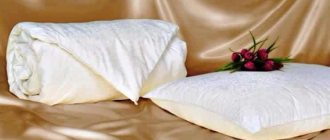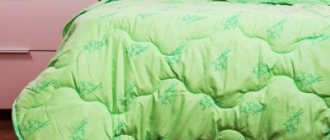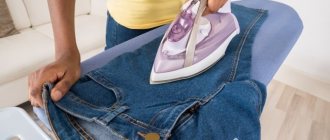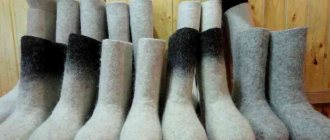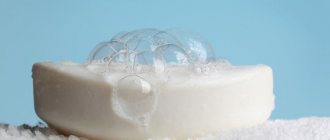Blankets, like other bedding, are an attribute of good rest. The quality of sleep, and therefore human health, depends on the condition of these products.
In order for them to perform their functions for as long as possible, it is necessary to properly care for them. Dust and dirt accumulate in any blanket over time. In addition, it gradually takes on an unaesthetic appearance. Therefore, each product needs regular cleaning, the rules and features of which depend on the composition of its filler. Some types can only be washed by hand, others must be dry cleaned, and others are “dry washable.” To choose the appropriate cleaning method, you must carefully study the information on the label, which indicates how to wash a blanket with a specific filling. Compliance with all recommendations for choosing the correct washing mode, optimal temperature, spinning and drying is the key to achieving the desired effect. If the product does not contain information about the need for dry cleaning, it can be washed by hand or in a machine. It should be remembered that any blanket that is subject to wet processing is recommended to be washed no more than 2-3 times a year.
Important! Blankets filled with cashmere or cotton are not machine washable and can be hand washed or dry cleaned. Items filled with sheep or camel wool should only be machine washed on the “wool” cycle.
Which blankets are machine washable?
Down, silk, as well as products with plant-based fillers or padding polyester can be machine washed. In order for the washing to be effective and the bedding to remain safe and sound, you need to know how to wash a blanket correctly and follow the requirements for cleaning these products.
Preparing for washing
Before loading the blanket into the machine, you need to:
- Check the cover for holes and integrity of seams. To prevent the filling from coming out during washing, you should sew up all the holes, and to prevent it from getting loose, repair any loose seams.
- Treat contaminants with a special chlorine-free product. Small stains can be rubbed with a sponge soaked in dissolved laundry soap.
- Remove dust by knocking it out or using a vacuum cleaner.
- Determine the weight of the product: it should not exceed the weight permissible when loading a particular washing machine.
- Check whether the blanket does not occupy the entire volume of the drum: after loading there should be at least some free space left.
- Before washing, the blanket should be folded several times and then rolled into a roll.
Only if all these conditions are met, washing a blanket in a machine will bring the desired result.
Rules for successful washing
In order for the product to wash well, it is necessary to choose the right detergent. Gels or liquid powders that have hypoallergenic properties are most suitable for this purpose. To wash down products, products containing lanolin are used: it protects the filler from matting. For silk items, a detergent for delicate fabrics is best. To soften the fibers of the blanket, make it even softer and give it a pleasant aroma, you can use a conditioner.
Note! When washing blankets of any kind, do not use bleach.
The average recommended water temperature for washing is 30-40°C. In most cases, the mode should be selected delicate, and the number of revolutions should be minimal. Along with the duvet, several rubber balls or tennis balls are usually placed in the machine so that the filler does not get lost.
Optimal temperature for machine washing
Unpretentious products with synthetic filler can withstand temperatures of 40-60℃. In order not to harm the quality of down or flannelette blankets, you should limit yourself to a temperature of about 40℃, and silk, wool or bamboo blankets can only be washed in cool water no higher than 30℃.
Choosing the right mode
Products filled with down are washed in the “cotton” mode with a spin speed of 800 rpm.
The most “capricious” bedding made of wool or silk can only be washed on a delicate cycle and with a soft spin, up to 500 rpm.
Blankets with natural fillings can be machine washed with a load capacity of 7 kg or more.
For products with silicone, padding polyester, nanofiber and other artificial fillers, you should select the “synthetics” washing program with a spin speed of 800 rpm. Their low weight allows them to be washed in a machine with a load capacity of 5 kg.
We recommend:
How to wash a jacket on padding polyester - manual and automatic washing
For brightly colored items, use the “gentle wash for colored fabrics” mode.
When should you take your item to the dry cleaner?
You can wash a padding polyester blanket, a blanket with holofiber, silicone or other artificial filler at home without much difficulty or risk. Expensive products, if the instructions have not been preserved, should be handled with extreme caution. In the following cases, you should entrust the washing of blankets to dry cleaning:
- if there is a suspicion that washing heavy wet items will damage the machine;
- if there are not sufficient conditions for drying;
- if you decide to wash your bedspreads in winter;
- if you decide to wash a cotton, feather, down blanket made from silkworm.
In other cases, you can act without fear. The procedure will not harm the product.
The article has been verified by the editors
Do I need to wash a new blanket?
If the purchased product is sold in packaging and there is no visible dirt on it, it is enough to simply ventilate it to eliminate the specific odor. If the blanket is not packaged, it should be washed, since it is unknown in what conditions the item was stored and how many hands touched it in production and in the store. Wash your blanket as usual, following the instructions on the label.
Important! Blankets intended for newborns must be washed regardless of the packaging, since babies' immunity has not yet developed, and their skin is highly sensitive to external influences. For washing it is necessary to use special children's products. If the blanket is not washable, you should definitely purchase a duvet cover (preferably cotton).
How to get rid of lumps
Fluff, feathers, and cotton wool tend to form lumps when washed, which are difficult to wash and dry. If the cotton wool or cotton is stuck in a ball, it will not be possible to resuscitate the item. Down and feathers will not form clumps during washing if you put special balls in the drum that break up the filler. During the drying process, manually breaking up the feathers and down will speed up the drying process and prevent caking of the material and the appearance of a musty smell.
Beating the fillers with a carpet clapper or vacuuming will loosen the filler and speed up drying. You should not exhaust, turn over or vacuum a wet product; excess water should drain and the blanket should dry out.
Is it possible to wash blankets with coconut filling?
Natural fillers of plant origin do not tolerate high temperatures and strong mechanical stress, so the washing temperature for such products in the machine should be 30℃, and the spin cycle should be either turned off or set at minimum speed. It is recommended to use double rinse and the shortest cycle. Coconut-filled blankets should not be soaked before washing, as prolonged moisture will destroy the fibers of the plant.
These tips will help you figure out how to properly wash a blanket in a washing machine. The variety of functions and modes of modern household appliances allows you to effectively clean blankets with different types of fillers from dirt. With proper preparation, the use of appropriate products, the correct choice of temperature and washing mode, the products become clean, maintaining the brightness of the colors and the original shape.
Rate this post
Drying rules
Drying a synthetic winterizer product is a simple and quick process. Remove a clean item from the washing machine or bath and stretch it a little to give it its original shape. Check for lumps and smooth them out with your fingers. Dry unfolded with natural ventilation. It is better if it is in a horizontal position on several dryers as indicated in the photo above. During the drying process, the item is turned over and shaken more than once.
On a summer day, it will take 4-6 hours for the blanket to air dry. Do not use heaters or a dryer to speed up the process.
It is recommended to wash a padding polyester blanket every three months.
Useful tips
- To avoid streaks after dry cleaning, we recommend shaking out the item first.
- It is also better to carry out dry cleaning using special products that can now be purchased at any store.
- If, after drying, the material begins to emit an unpleasant odor, the item will have to be replaced. Most likely, the filler did not dry completely and the accumulated chemicals began to oxidize. Mold may also develop, and this can have a very detrimental effect on the health of all family members.
- Do not set the spin speed above 800 rpm. This may damage things.
- Keep in mind that when wet, the product becomes twice as heavy. Pre-weigh it or look at the weight on the label. If the bedding weighs three kilograms, and the machine can only withstand five, then this cleaning method will not suit you.
- Do not use all kinds of shampoos and dishwashing detergents instead of liquid powder. They are not intended for technology.
- Cleaning
32 Surprising Items You Can Clean in the Dishwasher
Wet cleaning of cotton and silk blankets - instructions
Such bedspreads cannot be washed either in a machine or by hand. If the filler gets wet, it will immediately break down, and it will be impossible to return the bedspread to its original appearance.
Therefore, cotton should be cleaned as follows:
- If possible, hang the blanket outside. Carefully but gently knock it out and leave it to air for a while. If this is not possible, just give the product a good vacuum cleaner. If you do not clean it in advance, the accumulated dust will turn into dirt when it comes into contact with water.
- Grate the laundry soap and dissolve it in water. Then whisk the water until a thick foam forms.
- Apply foam using a brush and clean contaminated areas.
- Wipe off the foam with a washcloth washed in clean water and wrung dry.
As for silk products , it is enough to wipe them occasionally with a solution of water and ammonia, or water and alcohol . Simply soak a cotton swab in the resulting solution, squeeze it well and thoroughly wipe the contaminated areas. Then wipe the product again with a clean and well-wrung-out sponge.
Top 3 best products
Flannelette blankets are most often used for children. In this regard, the choice of detergent is especially important.
The requirements for them are quite strict:
- hypoallergenic composition;
- high efficiency;
- safety;
- good solubility;
- easy rinsing;
- lack of pronounced aroma.
If the flannelette blanket is intended for an adult, then the choice of detergent will be much wider, but you can also use those recommended for children.
Eared nanny
Washing powder “Eared Nannies” is available in various packaging. This detergent is suitable for children of any age, even newborns. The powder contains special components that soften water.
One of the main advantages of the product is its safety and high effectiveness against stains typical of children. The powder does not damage the structure of the material and has a light floral scent .
The price of the powder is from 380 rubles per package of 2.4 kg. The powder is not suitable for washing items containing wool.
The world of childhood
The “World of Childhood” laundry detergent is a soap powder that meets all the requirements for the care of children's laundry. It is effective against the most common childhood stains, is hypoallergenic, and maintains the brightness of the shades of washed items.
The powder is based on soap shavings , which do not contain fragrances, dyes or synthetic substances. Can be used from birth. Price – from 100 rubles per package of 0.6 kg.
Meine Liebe
Baby washing powder is a concentrate with enzymes. Can be used for machine and hand washing of a flannelette blanket.
Hypoallergenic, does not contain phosphates . Has economical consumption. Cost – from 480 rubles per 1 kg.
baby blanket
When washing a baby blanket, take into account the following recommendations:
Care should be regular (at least once every 1-1.5 months). It is carried out as needed.- You should only use specialized detergents, for example, “Eared Nanny” washing gel.
- To remove local contaminants, use laundry soap. The use of aggressive components is unacceptable.
- After washing, the item must be ironed, unless the manufacturer prohibits it.
To soften the fabric, you can use a hypoallergenic fabric softener, for example, Lenor Children's.
Designations on the label
Any textile product produced in a factory is supplied with a tag containing brief care instructions. You must follow them exactly if you want to preserve your purchase in its original form for as long as possible.
The markings on the blanket containing washing recommendations are pictograms, which can sometimes be difficult to decipher.
So, if only manual processing is allowed, then there is a schematic image of a basin filled with water, indicating the temperature of the latter. When it comes to a machine, there are recognizable contours of the unit.
The triangle indicates that the use of bleach is acceptable. When it is crossed out, such means are prohibited.
The circle indicates dry cleaning capability. A horizontal stripe underneath means delicate mode, and a double stripe recommends extreme caution.
The design of the iron makes it possible to use this device. The degree of its heating is indicated by points (from 1 to 3).
The square gives permission to wring out the item, and if a circle is inscribed inside, then it is allowed to do this in the drum.
You will find the decoding of other symbols in a separate article published on our website.
Preparation for the procedure
Before you start washing, you need to properly prepare your bedding.
It is recommended to do the following:
- Remove the item from the duvet cover.
- Eliminate all existing defects in the product. If there are any loose seams or holes, they need to be sewn up.
- Remove dust from the blanket. It can be knocked out, shaken out or vacuumed.
- Wash difficult stains in advance. To do this, use laundry soap, which is foamed and applied locally to the contaminated area.
- Fold the blanket correctly. It is folded several times, rolled into a roll and placed in the drum of the washing machine around the perimeter.
